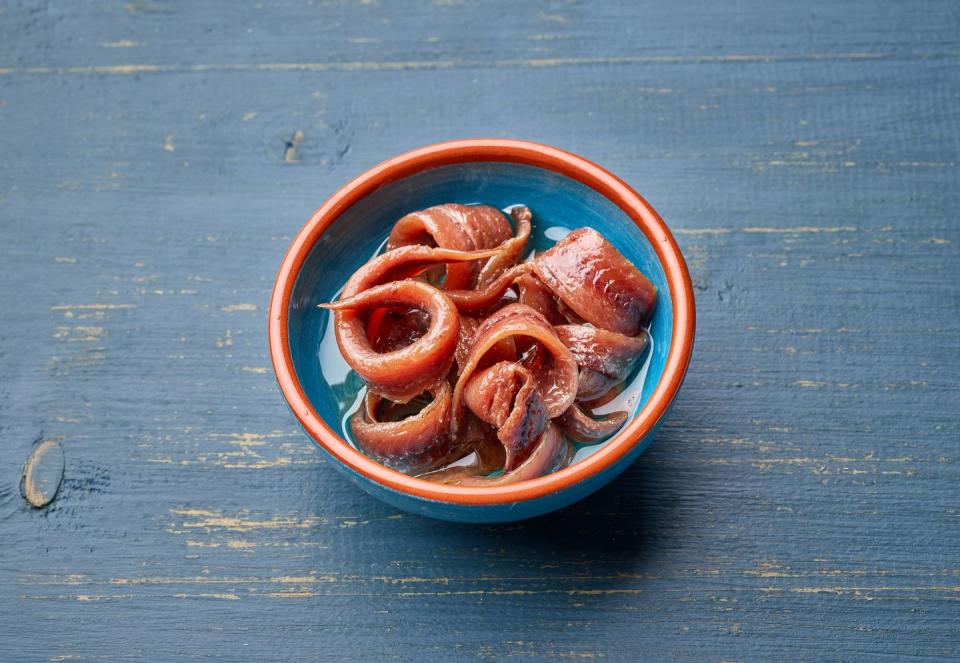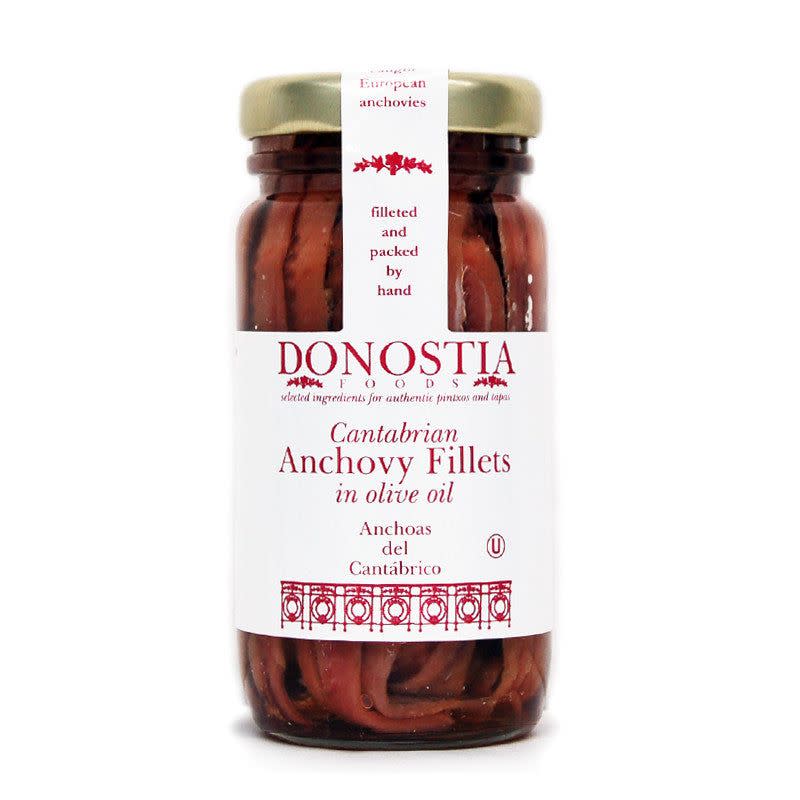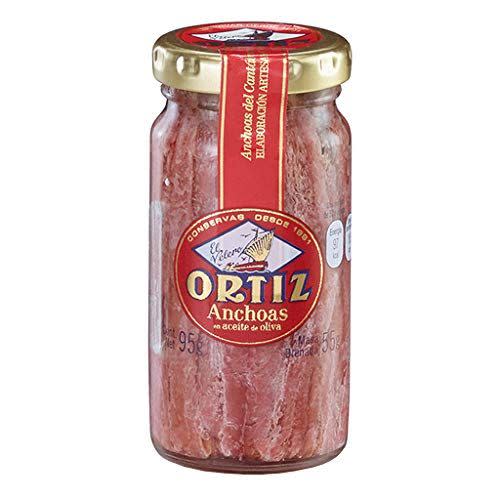Anchovies Are a Power Food, so Please Stop Hating on Them
"Hearst Magazines and Yahoo may earn commission or revenue on some items through these links."
THE BEST PIZZA I've ever tasted was in Italy.
It was one of those last-meal-on-earth pizzas, an ethereal soft-crisp crust graced with a simple sauce and adorned with capers, olives, and anchovies.
The worst pizza I’ve ever tasted also had anchovies. It was from one of those wannabe Neapolitan-style joints, and I felt like I was biting into a slice studded with soggy salt packets.
And that’s the whole situation with anchovies.
All along the Mediterranean coast, in South Asia, and elsewhere in the world, anchovies are revered for their flavor and nutrition, which drives a demand for higher-quality products. In America, they’re largely reviled, likely because of those run-ins we’ve all had and have since held deep within our psyches.
But something has shifted over the past several years. Though anchovies remain America’s least favorite pizza topping, according to a 2021 YouGov poll, popular cooking personalities (YouTube’s Matty Matheson and Joshua Weissman) have begun to trumpet the small but mighty fish as a versatile secret weapon that adds a boom of umami depth to any meal.

During the height of pandemic-induced home cooking, I watched anchovies attain Instagram stardom as people ate their way through shelf-stable foods. And professional chefs, too, are trying to celebrate the little fish for all it’s worth. At the Anchovy Bar in San Francisco, you can enjoy anchovy toast, fresh lime-pickled anchovies, anchovy steak tartare, and anchovies with fried onions and eggs, all made in-house from the day’s fresh catch.
Stuart Brioza, the restaurant’s executive chef, says he has to push back continually against people’s memories of bad anchovies. “For those who have suffered these shoddy products, it’s important for them to know that good anchovies are out there,” Brioza says.
Let’s be clear: All this anchovy hate is an American thing (even though the fish is in beloved Caesar salads). People have been eating anchovies for millennia.
In ancient Rome, anchovies were fermented into a rich, much-loved condiment. In Spain, vinegar-marinated anchovies are popular as tapas. In Korea, stir-fried dried anchovies with sesame seeds are a common side dish.
Moroccan restaurateur Badr Benjelloun says, “The anchovy is to seafood what Kris Kristofferson is to rock and country music.” Unpretentious, accessible, easy to enjoy. So what gives, America?
Flavor Is Sin!
While there’s no clear record of exactly when or why we turned on anchovies, you could blame the American legacy of puritanism. In his book American Cuisine and How It Got This Way, historian Paul Freedman, Ph.D., writes that “the open disdain for taste began with the food reformers of the 19th century.”
This is when religious dietary reformers (real thing!) such as minister Sylvester Graham and John Harvey Kellogg, M.D., gained influence by promoting a lifestyle free of sin and sexual urges through a diet of minimally processed and unseasoned food.
The basic idea, which carried through the Great Depression: Nourishing food should be plain because condiments and seasonings inflame the appetite and lead to overconsumption and illness. This idea persisted after food was no longer scarce.
And then along comes the ’chovy.

Alberto Recca, brother of the head of Agostino Recca, an anchovy producer in Sicily, speculates that anchovies came to America with Mediterranean immigrants: More than 4 million Italians arrived in the U. S. between 1880 and 1924. These Italians were labeled “garlic eaters,” a slur used by some to connote uncleanliness, immoral nature, and a proclivity for crime and violence.
According to food historian Linda Civitello, Ph.D., anti-Italian xenophobia and mainstream rejection of “smelly and unsophisticated” Italian food lasted until after World War I, when the popularization of pizza chains finally made Italian food “American.”
But even then, anchovies would remain a hard sell. Eventually, the supplement industry decided to swoop in and turn them into soft capsules.
The Omega Fish
Despite how much we despise the anchovy, we sure could benefit from eating a lot more of them. The annual per capita, according to the National Oceanic and Atmospheric Administration, which is a full seven pounds below the USDA’s dietary recommendation.
“The recommended intake omega-3 per the National Institutes of Health for men is 1.6 mg per day,” says Angela Merwin, a registered dietitian in Wichita, Kansas. (A 3.5-ounce serving of anchovies has 1.4 mg.) “It’s also a decent source of vitamin D, another one of those nutrients Americans are typically a little deficient in.” And because of their lower position on the food chain, anchovies contain less toxic mercury than salmon.
But still, the flavor.
So when research in the late 1970s and ’80s began to emerge indicating that people with diets high in omega-3’s were dramatically less likely to die from coronary heart disease, the supplement industry took notice. As more research was published and buzz built, the fish-oil-supplement sector grew (and it’s still growing).

A common source of omega-3’s for many of these brands?
Anchovies.
They don’t market the fact on the front of the label, but spin to the tiny-type ingredients list on brands like Hum, Life Extension, and Puritan’s (!) Pride and there they are. Some companies have even removed the offending “fish burp” for you.
If you’re looking to live forever on fish-oil pills, you’ll be bummed to hear that a new scientific understanding has developed during the past ten years. “Research indicates that omega-3 supplements don’t reduce the risk of heart disease,” according to the NIH. “However, people who eat seafood one to four times a week are less likely to die of heart disease.”
Luckily, for your health and your taste buds, finding better-quality anchovies and using them in your cooking is easier and more delicious than ever.
Embrace the Umami
Stuart Brioza, of the Anchovy Bar, says that if you’ve ever had a terrible anchovy, it’s because the manufacturer likely used smaller fillets—larger ones don’t soak up a face-puckering amount of salt—and likely froze them for an extended time before packing them in subpar oil.

Wild White Anchovies in Extra Virgin Olive Oil
amazon.com
Thanks to higher-end grocery stores and the Internet, you can now source better-quality anchovies. You can find fresh anchovies at fishmongers on both coasts.
While you can get both salt-packed and oil-packed anchovies in most stores, oil-packed is the most ready-to-eat variety, and a good-quality brand can literally be eaten out of the tin, says Tim Marchman, who writes Popping Tins, a Substack newsletter devoted to tinned seafood. “I don’t always want to heat up the oven or the grill . . . and sometimes I can’t because it’s the middle of the day and I have a half-dozen things going on. . . . Sometimes I’m camping.”

Cantabrian Anchovies in Olive Oil
donostiafoods.com
There are so many ways to use anchovies to enhance your meals.
My Italian friend Emanuele Zambolin likes to add them to olive oil in the skillet whenever he’s sauteing vegetables. Tao Leigh Goffe, Ph.D., a cultural historian, blends tinned anchovies, along with their oil, and adds all that to tuna salad. Melissa Clark, a New York Times food columnist, adds anchovies to her pasta sauce and salad dressings and rubs them with garlic on turkey before roasting.

Anchovy Fillets in Oil
amazon.com
The effect anchovies have on all these dishes is the same: The taste is more robust, more deeply savory, and just way more good.
I’ve taken to cooking with anchovies more since writing this article, and guess what: On top of being great for you, they don’t even give you fish burps.
4 Easy Ways to Love the Anchovy
On Toast
Slice of good bread, toasted + 1 to 2 anchovy fillets mashed with a little lemon juice
and 1 Tbsp good unsalted butter + freshly ground black pepper
With Roasted Vegetables
Florets from 1 head cauliflower, roasted + 1 to 2 anchovy fillets, minced + good glug nice olive oil + pile of freshly grated Parmesan
In Butter on Steak
Grilled rib eye + 1 to 2 anchovy fillets mashed with 1 Tbsp good unsalted butter and 1 Tbsp blue-cheese crumbles + scattering of chopped parsley
In Pasta
½ lb whole-wheat spaghetti, cooked + 2 anchovy fillets, minced + 1/4 cup breadcrumbs, toasted + 2 Tbsp olive oil + big pinch crushed red-pepper flakes + salt and pepper
A version of this article originally appeared in the April 2023 issue of Men's Health.
You Might Also Like

